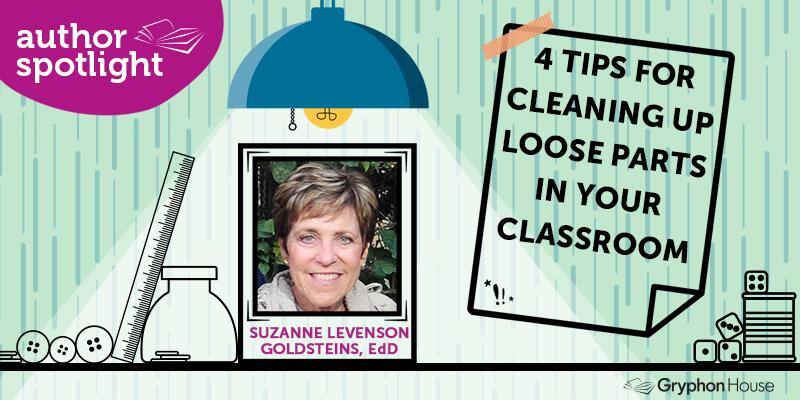4 Suggestions for Cleaning Up Loose Parts in Your Classroom
November 9th, 2021 | 3 min. read

Many educators—even those who are not “clean freaks”—are often hesitant to implement the use of loose parts in the classroom because they believe it is just not worth the mess. A common myth is that loose parts are simply junk piled in a corner, overwhelming to look at or motivate children to use, and difficult to clean up. Suzanne Levenson Goldstein, EdD—co-author of Loose Parts Learning in K-3 Classrooms—dispels this myth and gives us 4 tips for cleaning up loose parts in the classroom. With organization and student involvement, clean-up can be a breeze and your students will gain all the learning benefits of using loose parts. Get the book for more guidance on using loose parts in the elementary classroom, from integration with curriculum to clean-up!
Hello. My name is Suzanne Levenson Goldstein, and I am one of the co-authors of the Gryphon House published book— Loose Parts Learning in K-3 Classrooms. Today, I would like to focus on some tips for cleaning up loose parts in your classroom.
When first starting with loose parts, you may feel a little overwhelmed with all the stuff or loose parts, but just know that all of the loose parts have a purpose. You may not know it when it's collected and brought to class, but over time, each loose part can be used as an eye, a costume, a building, or even some things that we can't even imagine yet. The children will let you know. Here are four top suggestions for cleaning up loose parts in your classroom.
1. Start Small
Number one— start small. Start with one area or center in your classroom. When I started using loose parts, I started with my art area. My principal told me to start small, and to become an expert in that area. That was excellent advice. As I created the art area, I used all sorts of storage bins and boxes and shelves and baskets and plastic shoe boxes to hold all of the loose parts. Of course, the children were involved in creating and they brought in all kinds of loose parts.
Be sure to let the children know if there's any special rules in that area related to safety using the tools. For example, in the art area, there were scissors. So we needed to learn about the safety of using scissors. Be sure that the children know the expectations for cleanup in that area and for putting away all the materials back in the storage containers.
2. Make Defined Spaces
Number two— make defined spaces. I found that my students like to have defined spaces for loose parts. Any storage container will do. However, I did find that clear plastic shoe boxes worked well because they could be labeled and the children could see through the container.
Then I had different areas or centers like the reading corner, the art area, the science area, the take-apart center, and the math area. The children knew when cleaning up where to put each of the loose parts.
3. Make Fun Part of the Cleanup Process
Tip number three— make fun part of the cleanup process! I would often sing the “cleanup song” in my froggy singing voice. Thank goodness, the children didn't mind! By the time the song was over, the children knew that they needed to be sitting on the rug. I've also seen some teachers use an egg timer on a smart board. It's very visual, and when all of the salt goes down, the children know that cleanup time is over.
If the children don't want their project to be cleaned up and they want to work on it the next day, I always told them to put a note on it so that their project wouldn't be disturbed. If the children are not writing yet, they can always draw a hand and put a line through it. That's the indication that they don't want it to be cleaned up.
4. Use Tools to Help with Cleanup
The fourth tip is to use tools to help with cleanup. Use any container, basket, or box to help with cleanup. My students always loved it when I got out the masking tape and I would tear off a little piece of masking tape. They would go to the carpet, they would pick up all kinds of things on the carpet with their piece of masking tape, and then they would throw it into the trash can. That was really a fun way to clean up the classroom.
I also had a broom and a dust pan. I also had a hand vacuum and a carpet sweeper, and the children loved using all of those things to clean up. The parents would always say, “How do you get them to clean up in the classroom? I can't get them to clean up at home!” I just love this sign and it says, “Please excuse the noise and the mess. The kids are making happy memories.”
So please check out our book— Loose Parts Learning in K-3 Classrooms— published by Gryphon House, and you'll find a lot more cleanup ideas along with many other excellent tips for starting to use loose parts or expanding the use of loose parts in your classroom.
Thank you for listening!
Author(s)Tricia Rosengarten, Carla Gull, Suzanne Goldstein
A graduate of Appalachian State University with B.S. in Communication - Electronic Media and Broadcasting, Jaimee Council served a content strategy team lead for Gryphon House and Kaplan Early Learning Company from 2021-2022. Her talents include writing, photography, video production, audio production, blog management, website content management, social media management, some design, and data analytics for websites, social media, and customer relationship databases.
Topics: